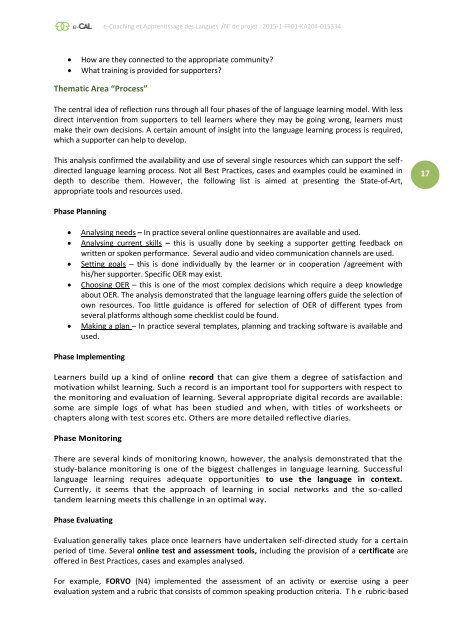e-CAL - e-Coaching et Apprentissage des Langues
The ERASMUS+ project e-CAL presents the result of an analysis of support methods in the case of language learning using web-based Open Educational Resources (OER).
The ERASMUS+ project e-CAL presents the result of an analysis of support methods in the case of language learning using web-based Open Educational Resources (OER).
You also want an ePaper? Increase the reach of your titles
YUMPU automatically turns print PDFs into web optimized ePapers that Google loves.
e-<strong>Coaching</strong> <strong>et</strong> <strong>Apprentissage</strong> <strong>des</strong> <strong>Langues</strong> /N° de proj<strong>et</strong> : 2015-1-FR01-KA204-015334<br />
<br />
<br />
How are they connected to the appropriate community?<br />
What training is provided for supporters?<br />
Thematic Area “Process”<br />
The central idea of reflection runs through all four phases of the of language learning model. With less<br />
direct intervention from supporters to tell learners where they may be going wrong, learners must<br />
make their own decisions. A certain amount of insight into the language learning process is required,<br />
which a supporter can help to develop.<br />
This analysis confirmed the availability and use of several single resources which can support the selfdirected<br />
language learning process. Not all Best Practices, cases and examples could be examined in<br />
depth to <strong>des</strong>cribe them. However, the following list is aimed at presenting the State-of-Art,<br />
appropriate tools and resources used.<br />
17<br />
Phase Planning<br />
<br />
<br />
<br />
<br />
<br />
Analysing needs – In practice several online questionnaires are available and used.<br />
Analysing current skills – this is usually done by seeking a supporter g<strong>et</strong>ting feedback on<br />
written or spoken performance. Several audio and video communication channels are used.<br />
S<strong>et</strong>ting goals – this is done individually by the learner or in cooperation /agreement with<br />
his/her supporter. Specific OER may exist.<br />
Choosing OER – this is one of the most complex decisions which require a deep knowledge<br />
about OER. The analysis demonstrated that the language learning offers guide the selection of<br />
own resources. Too little guidance is offered for selection of OER of different types from<br />
several platforms although some checklist could be found.<br />
Making a plan – In practice several templates, planning and tracking software is available and<br />
used.<br />
Phase Implementing<br />
Learners build up a kind of online record that can give them a degree of satisfaction and<br />
motivation whilst learning. Such a record is an important tool for supporters with respect to<br />
the monitoring and evaluation of learning. Several appropriate digital records are available:<br />
some are simple logs of what has been studied and when, with titles of workshe<strong>et</strong>s or<br />
chapters along with test scores <strong>et</strong>c. Others are more d<strong>et</strong>ailed reflective diaries.<br />
Phase Monitoring<br />
There are several kinds of monitoring known, however, the analysis demonstrated that the<br />
study-balance monitoring is one of the biggest challenges in language learning. Successful<br />
language learning requires adequate opportunities to use the language in context.<br />
Currently, it seems that the approach of learning in social n<strong>et</strong>works and the so-called<br />
tandem learning me<strong>et</strong>s this challenge in an optimal way.<br />
Phase Evaluating<br />
Evaluation generally takes place once learners have undertaken self-directed study for a certain<br />
period of time. Several online test and assessment tools, including the provision of a certificate are<br />
offered in Best Practices, cases and examples analysed.<br />
For example, FORVO (N4) implemented the assessment of an activity or exercise using a peer<br />
evaluation system and a rubric that consists of common speaking production criteria. T h e rubric-based


